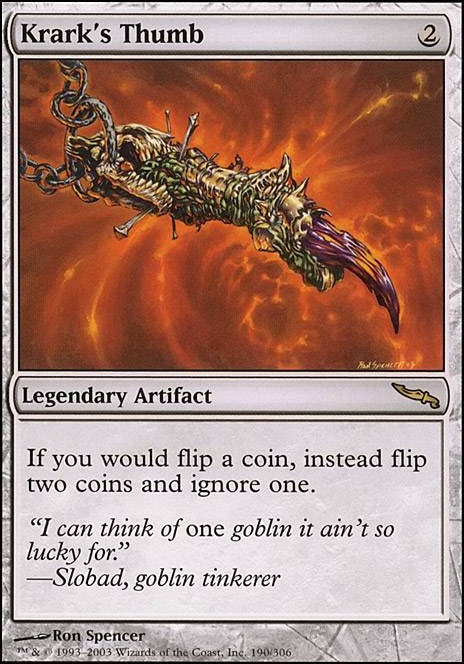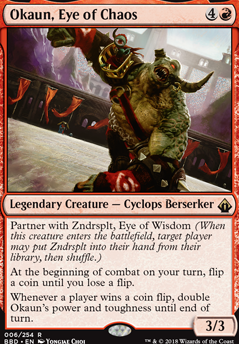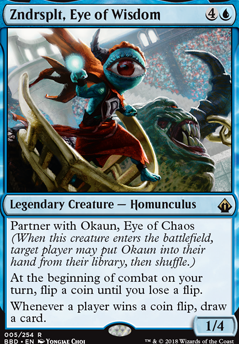Deck Rating: 7 out of 10
Deck Strategy: Coin Flip, Combo
For all of my 20+ years playing Magic, I've always looked with curiosity and enthusiasm at the coin flip mechanic. Unfortunately, while I trialed coin flip cards in some of my red decks, the fact remained that they never quite worked reliably. So I'd invariably swap them out again - but I never quite forgot about them. Looking into the mechanic recently, I discovered Okaun, Eye of Chaos and Zndrsplt, Eye of Wisdom for the first time. I couldn't believe the potential, and immediately set to digging up all the coin-flip cards I'd collected throughout the years. When it turned out that the coin-flipping by itself would be insufficient to build a full deck around, the inclusion of Krark, the Thumbless inspired an additional spell-copying element. With this added, the deck and its purpose began to take shape.
The mission: flip coins. An absolutely ungodly amount of them...
The core of this deck are its commanders, which you should strive to get out as quickly as you can. Not only can they generate bountiful coin-flipping between the two of them, they also gain you value off of it. Every coin flip that any player wins at the table triggers their abilities. Okaun, our main hitter, doubles his power and toughness until end of turn for every flip won. With lots of flips, he can get enormous very quickly. Our real powerhouse, though, is humble Zndrsplt. For every won flip, she will draw us a card - simple as that. As you might imagine, with double-digit coin flips on each of your turns, the value gets insane in a heartbeat.
Embracing the power of chaos and turning it to our ends is this deck's strength - and its weakness. With the amount of cards it can draw you, there is a very real risk of decking yourself just by playing normally. That does make it exciting to run, though; you'll never have a boring game with this one. There will be turns where you will win 0 coin flips; accept this, and know that your next turn(s) might see 18 won flips (more on this later). A positive, glass-half-full attitude is key to piloting this deck.
Practically, we want to run this one in two phases:
-
Build the Flip Machine. Primarily, we want to focus on creating a solid board-state for ourselves. Don't go on the offensive early; if all goes according to plan, you'll only need Okaun to win. Bring out Zndrsplt and as many coin flip effects as you can. Use the resulting card-draw to consistently hit your land drops and bring out mana rocks. You can bring Okaun out at this juncture for extra coin flips, but he is a scary, scary guy and may draw more attention than you're comfortable with.
-
Go Nuts!. The moment that you have a nice coin-flip system going and have drawn a 'Kill Card' (see below) is when you can shift into high gear. Bring out Okaun, and flip him into insane power. If your opponents have interaction, they will likely use it now; save up your counterspells to keep him safe! You can use Veil of Secrecy to smash Okaun into a single foe, reliably knocking them out. However, he does not need to attack for us to take out our foes. Instead, we can use a Kill Card: Surestrike Trident and Burning Anger are excellent ways for Okaun to shoot people in the face. However, pride of place goes to Soul's Fire as it synergizes with the spell-copying subtheme of this deck. A double-copied Soul's Fire will finish off all your opponents in one fell, dramatic swoop.
Should Okaun be hated off the board so consistently that you can't bring him back (unlikely, considering the carddraw and ramp this deck is capable of), we can win through a Chance Encounter. With an established board, you'll probably accrue the 10 luck counters on the very turn you play it - the real trick is keeping it (and yourself) alive until your next upkeep!
Making this deck work consistently requires a number of support pillars, all essential in creating the gleeful chaos machine that we'll unleash on our foes:
- Ramp, as ever, is integral to carry your deck into the late game. With Zndrsplt out, we will almost never be drawing a single card per turn. Your hand can overflow quickly; therefore we have a Thought Vessel and Reliquary Tower available. However, we are primarily aiming to play the many cards we draw. Therefore, we have rocks aplenty (Sol Talisman, Sol Ring, Arcane Signet, Talisman of Creativity, Commander's Sphere, Letter of Acceptance) and two-color lands for fixing (Riverglide Pathway
, Frostboil Snarl, Izzet Boilerworks, Silverbluff Bridge, Swiftwater Cliffs, Sulfur Falls, Temple of Epiphany, Shivan Reef, Thriving Bluff, Thriving Isle). We also have a number of ways to get more lands out per turn (Walking Atlas, Terrain Generator, Sword of the Animist, Burnished Hart), and special attention should be given to Tavern Scoundrel. This humble MH2 Common card generates two Treasure tokens per won coin flip. Dropping him early will help smooth out your buildup; dropping him later will make your opponents' jaws drop at the stupendous value it can generate. With a toughness of 3, it's very much boltbait.
- 'Removal' is what we run in quotes because we have surrendered reliability for greater synergy with our theme. To get rid of creatures we have Goblin Kaboomist, Mogg Assassin, Goblin Bangchuckers, Karplusan Minotaur, Goblin Assassin and Crooked Scales, all of whom include a coin-flipping element. To get rid of oppressive artifacts, we also have access to Goblin Archaeologist, Prismari Command and Shenanigans. In those rare situations where we find ourselves in need of removing other things, Introduction to Annihilation is the discrete option, and Boompile the indiscriminate.
- Copy Effects are the secondary powerhouse of this deck, and at their best they interact with our coin-flipping needs. To start we have static copy providers like Rowan, Scholar of Sparks
's emblem, Krark, the Thumbless and Mirror March. Rowan and Krark give us copies of our spells, the March creates creatures for us - ideally with ETB triggers, but as with Krark, it's about the flips, silly! For even more copies, we have instants and sorceries available. Galvanic Iteration, Teach by Example and Howl of the Horde all work quite well, and combined with the static effects and stacking with one another can generate a huge amount of copies. We'll go into more detail regarding this under the Combos and Interactions header below.
- Coin Flippers are cards that, while they provide other functions, primarily exist to flip us as many coins as possible. Our commanders fall in this category, alongside Ral Zarek, Yusri, Fortune's Flame, Karplusan Minotaur, Crazed Firecat, Fiery Gambit, Mirror March and most of all Squee's Revenge. To use this last one, just select an arbitrarily high number of flips (~50) - most times, we don't actually want to win them all. If we do, we will draw a stupendous number of cards, especially combined with Zndrsplt. Let's not deck ourselves, shall we?
Combos and Interactions
This deck runs a number of value-enhancing combos, and some of our cards interact with each other in interesting ways. Let's take a look:
- Spell-copy stacking gets stupid really fast. In your second main phase, with Krark, the Thumbless and Rowan, Scholar of Sparks
' emblem out, play a Teach by Example, and copy it twice. Then play Howl of the Horde, and see it copied five times, then let off your next spell, which will be copied a whopping fourteen times. Have fun.
- In the same vein, any copying effect + a kicked Maddening Cacophony is wild, because it copies the kicked version of the spell. With EDH decks the size that they are, barring your opponents' having any effects that return cards automatically to their library (i.e. Darksteel Colossus, Worldspine Wurm), 5 to 6 copies of Maddening Cacophony will mill all of your opponents out in one fell swoop. As you can see above, making that many copies is a breeze.
- Shenanigans is a great card on its own, but with Zndrsplt's carddraw, your opponents can kiss all their artifacts goodbye. And that's not even considering copies!
- Mirror March is a fantastic card in combination with ETB effects (plus attack-triggered or tap-to-activate abilities, as the tokens gain haste). The world is your oyster: Solemn Simulacrum, Walking Atlas, Burnished Hart, Goblin Traprunner, Goblin Assassin, Tavern Scoundrel. These last two are especially ridiculous. If the gods of chance are on your side, you can have opponents sac tons of creatures, and generate hundreds of Treasure tokens.
- Last but by no means least, Krark's Thumb. This is the card that elevates the deck from fun to powerful. By raising your chances of success from 50% to 75%, this artifact is the powerhouse that keeps it all going. Keeping a counterspell on hand to save it from removal is highly recommended.
Pet Cards
To me, Commander is a format where fun is first, and competition second. As such, almost every deck I make will have some cards that are probably not the best choice for inclusion. They're there to stay, though, for no other reason that I like their art/flavor/design.
- Goblin Bomb - This was an old trade of mine, back when I didn't really understand the card. As such, it sat in my binder for years and years, never used - until now! It's not a great card here; it would perform far better in a Proliferate deck. What it does provide is a reliable flip on all of your turns, and a distracting low-CMC threat for your opponents to fixate on. Plus, actually getting to use it is hilarious.
- Planar Chaos - Man, if you're about to start your Okaun rampage or have put Chance Encounter out, this card is like a dirty bomb; you never know what will survive and what won't. Personal record with this is 7 whole pieces of interaction nullified in a full turn cycle. Spicy.
- Impulsive Maneuvers - This is a great catalyst for chaos, as you also flip for each of your opponents' creatures that attacks. A warning: clever players with huge token boards can exploit this to have Zndrsplt deck you if you're not careful. This enchantment reaches its true potential with Krark's Thumb out, allowing you to choose more strategically which creature has its damage doubled and which gets nixed.
- Mirage Mirror - The utility on Mirage Mirror is just too fantastic to pass up. Any great thing your opponents bring out, you can have too, for a turn at least. It's also excellent when duplicating your own utility cards (Well hello, double Mirror March!).
- Uvilda, Dean of Perfection
- Uvilda's a great help when you're not getting off the ground early. Put your utility spells in Park, and wait for the discount. Nassari, on the other hand, provides excellent lategame value, giving you access to opponents' tools and growing a powerful blocker.
An Aside: The Challenge of Non-Infinite Combos
I'd like to take the opportunity at the end of this write-up to relay a little anecdote about this deck in play, and what it means to me from a deck-building perspective.
It's my turn, and it's just me and two other opponents left. One has swung out; all his creatures are tapped. The other has a sizable board of blockers. Through various means, I manage to win 18 coin flips before attackers are declared. I send Okaun at the player without blockers, who promptly dies from 786,432 (commander) damage. However, that leaves the other opponent. So, in my second main phase, using the Treasures I reaped from Tavern Scoundrel, I set up a Teach by Example into Howl of the Horde, into a Soul's Fire, which gets copied four times. Five instances of the spell combine to let Okaun close out the game, by dealing 3.9 million damage directly to the player's face.
So, why is this significant? It's just a game I won. However, in my experience, it demonstrates the joy of creating a combo that allows you to achieve incredible numbers, without having to resort to infinite loops. In MTG, there are quite a few ways to create such a loop, allowing you to do a certain thing as much as you want. Create infinite mana, take infinite turns, deal infinite damage - you've all heard the stories. Yet once an infinite combo is in place, and your opponents do not have interaction available, the game is typically over.
Whenever I have won by infinite combo or lost to it, it felt like an unsatisfying ending. You explain a potential victory, laying out to your opponents precisely how it works, and them concurring that you will (eventually) win. What I realized was that it lacked the drama, the visceral twists and turns of a battle fought to the finish. While infinite combos are all well and legal (and essential in some tournament formats), I'd argue for a new paradigm in EDH: to strive to achieve astounding results, without going infinite. For those who can rise to the challenge, it makes for more involved deck-building, and more exciting games.
If you liked this deck, please leave an Upvote, or write a comment below! If you want to see more mechanically interesting decks with detailed write-ups, head to my user page. Here you can easily find all of my decks, listed by color combination, commander and mechanics!





